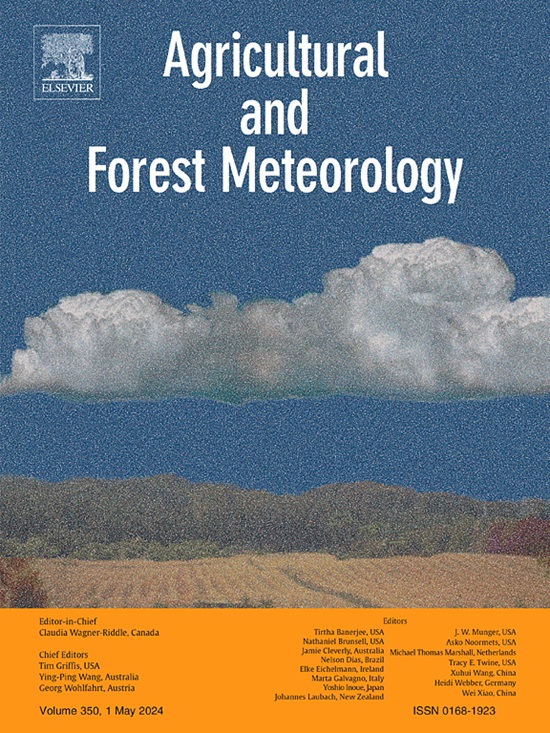Forest fertilization transiently increases soil CO2 efflux in young Norway spruce stands in Sweden
IF 5.6
1区 农林科学
Q1 AGRONOMY
引用次数: 0
Abstract
Late-rotation fertilization of Norway spruce stands is a frequently used management tool in Fennoscandia to increase timber yields. Meanwhile, the growing demand for renewable resources has sparked great interest in earlier and repeated fertilizer application but it remains unclear how this affects carbon dioxide (CO2) fluxes in the understory, especially forest floor respiration (Rff). This study investigated the effects of forest fertilization on Rff and net forest floor exchange (NFFE) in young, nitrogen (N) limited Norway spruce stands in southern Sweden. In a short-term dose experiment, Rff and NFFE were recorded during 2016 after varying doses of N (0, 150, 300, or 450 kg ha-1 of N, hereafter N0, N150, N300, N450) were added to circular, 3-m-diameter plots in April. In a second, long-term experiment, two stand-level fertilizer applications with 150 kg ha-1 of N on each occasion were performed in 2014 and 2016 and Rff was measured at semi-regular intervals from mid-2013 to the end of 2017. In the dose experiment, fertilization increased Rff by 23 %, 81 % and 55 % in the N150, N300 and N450 treatments, respectively. Under well-lit conditions, the N300 and N450 treatments significantly enhanced photosynthetic CO2 uptake of the forest floor vegetation by 97 % and 66 %, respectively, while the N150 treatment had no significant effect. The results of the long-term experiment indicate an initial stimulation of Rff, but this effect was transient. Our findings imply that fertilization in young Norway spruce stands, using the N150 dose (the typical dose used in Swedish forestry), may cause a transient burst in Rff that is far outweighed by nutrient-driven increases in forest floor photosynthesis under favourable light conditions prior to canopy closure.
森林施肥会瞬时增加瑞典挪威云杉幼林的土壤二氧化碳排放量
挪威云杉林的晚轮施肥是芬诺斯坎迪亚地区为提高木材产量而经常采用的一种管理手段。与此同时,对可再生资源日益增长的需求引发了人们对提前和重复施肥的极大兴趣,但目前仍不清楚这对林下二氧化碳(CO2)通量,特别是林地呼吸作用(Rff)有何影响。本研究调查了森林施肥对瑞典南部氮(N)受限的挪威云杉幼林的Rff和林地净交换量(NFFE)的影响。在一项短期剂量实验中,于2016年4月在直径为3米的圆形地块中添加不同剂量的氮(0、150、300或450千克/公顷,以下简称N0、N150、N300、N450)后,记录了Rff和NFFE。在第二个长期实验中,2014 年和 2016 年进行了两次立地施肥,每次每公顷施氮 150 千克,从 2013 年年中到 2017 年年底,每隔半固定时间测量一次 Rff。在剂量试验中,N150、N300 和 N450 处理的 Rff 分别增加了 23%、81% 和 55%。在光照充足的条件下,N300 和 N450 处理分别显著提高了林地植被对二氧化碳的光合吸收率 97 % 和 66 %,而 N150 处理则没有显著影响。长期实验的结果表明,施肥最初会刺激 Rff,但这种效应是短暂的。我们的研究结果表明,在挪威云杉幼林中施肥,使用N150剂量(瑞典林业使用的典型剂量),可能会造成Rff的短暂爆发,但在树冠郁闭之前的有利光照条件下,林地光合作用的养分驱动增长远远超过了这种爆发。
本文章由计算机程序翻译,如有差异,请以英文原文为准。
求助全文
约1分钟内获得全文
求助全文
来源期刊
CiteScore
10.30
自引率
9.70%
发文量
415
审稿时长
69 days
期刊介绍:
Agricultural and Forest Meteorology is an international journal for the publication of original articles and reviews on the inter-relationship between meteorology, agriculture, forestry, and natural ecosystems. Emphasis is on basic and applied scientific research relevant to practical problems in the field of plant and soil sciences, ecology and biogeochemistry as affected by weather as well as climate variability and change. Theoretical models should be tested against experimental data. Articles must appeal to an international audience. Special issues devoted to single topics are also published.
Typical topics include canopy micrometeorology (e.g. canopy radiation transfer, turbulence near the ground, evapotranspiration, energy balance, fluxes of trace gases), micrometeorological instrumentation (e.g., sensors for trace gases, flux measurement instruments, radiation measurement techniques), aerobiology (e.g. the dispersion of pollen, spores, insects and pesticides), biometeorology (e.g. the effect of weather and climate on plant distribution, crop yield, water-use efficiency, and plant phenology), forest-fire/weather interactions, and feedbacks from vegetation to weather and the climate system.

 求助内容:
求助内容: 应助结果提醒方式:
应助结果提醒方式:


